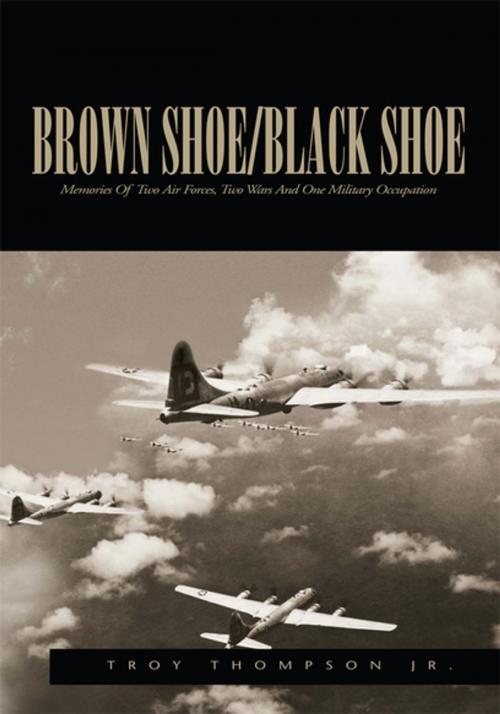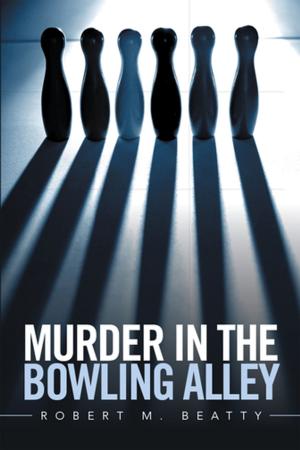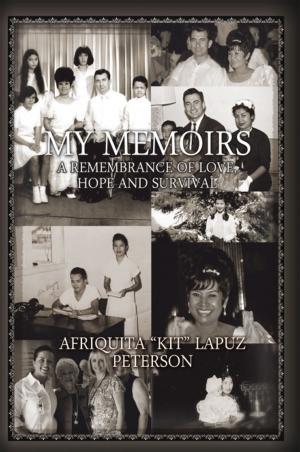Brown Shoe/Black Shoe
Memories of Two Air Forces, Two Wars and One Military Occupation
Biography & Memoir, Historical| Author: | Troy Thompson Jr. | ISBN: | 9781469107974 |
| Publisher: | Xlibris US | Publication: | January 22, 2004 |
| Imprint: | Xlibris US | Language: | English |
| Author: | Troy Thompson Jr. |
| ISBN: | 9781469107974 |
| Publisher: | Xlibris US |
| Publication: | January 22, 2004 |
| Imprint: | Xlibris US |
| Language: | English |
The narrator grew up in pre-WWII days loving aircraft; in his case, model aircraft and stories of flying. While hes in college World War II begins. Not relishing the idea of becoming an Infantryman, he signs up for the Armys Aviation Cadet program as a desirable alternative to being drafted. Approximately a year later (April 1943) the Army calls him to active duty for training as an air crewman. When he leaves Birmingham-Southern College its into a different life style, that of an Army trainee. You follow him as he tells of his more memorable moments in training. First is the inevitable Basic Training at Keesler Army Air Base in Biloxi, Mississippi. At Keesler there are the basic military things to learn and dodrilling, Kitchen PoliceKP, physical examinations by the medics and the all-important physical trainingPT.
From Keesler he goes to the College Training Detachment at the University of Tennessee. The CTDs, located at many colleges and universities, are mostly a holding operation for the prospective aircrew trainees where they wait their turn for going into actual flying training. The only meaningful activity is the continuation and increased emphasis on physical conditioning in the PT classes. Next there is a month in the Classification Center in Nashville Tennessee where he is identified as being either a prospective Pilot trainee or Navigator trainee.
At the Armys Maxwell Army Air Base in Montgomery, Alabama, the narrator spends two months in Pre-Flight training. This is his introduction to life as an Aviation Cadet. He tells of the frequent inspections, the formal military parade ceremonies and life in the war-time Cadet program. As this phase ends, he and his fellow Cadets leave to go into actual flight training.
Flight training for the narrator begins at Carlstrom AB in Arcadia, Florida. He tells us about the training aircraft-the Stearman biplane-- and what a trainee does in learning to fly it. After his solo flight, he is reclassified as a Navigator trainee. Pilot training ends for him and Navigator training begins.
But before Navigation school there must be training in aerial gunnery, since Navigators on bombers also act as gunners. Gunnery instruction is at Buckingham AAB in Fort Myers, Florida. There he spends what seemed like endless hours in class memorizing the parts of the aircooled machine gun. This was before any firing practice begins. Much of the firing practice is skeet shooting; sometimes conventional skeet shooting and later shooting skeet from the back of a moving truck. The practice-firing of machine guns in the air from a B-17 bomber completes the training.
Navigation School in Coral Gables Florida is a joint venture of several independent entities. The University of Miami provides the physical facilities. The Embry-Riddle Co. provides housekeeping services. Pan American Airways, which had been the pioneer in over-water air navigation, provides classroom instruction in navigation and instructors for in-flight training. And the Army Air Corp still kept the military control and instruction for the cadets. The narrator tells us a little about aerial navigation (in very non-technical language) and experiences of the Cadet trainees as they fly in Pan Americans vintage flying boats. When the training is completed the Cadets receive their aeronautical ratings as Navigators and commissions as Army Second Lieutenants or Flight Officers.
The narrator tells about meeting Estelle, the woman who becomes his wife in a marriage which disproves the notion that war-time romances are not permanenttheir marriage lasts over forty-nine years and ends only with her death!
A short period of radar training in Boca Raton, Florida and a month in a crew-assembling pool in Lincoln, Nebraska. lead into B-29 training at the Air Base in Pyote, Texas. The colorful nickname for the base is Rattlesnake Bomber Base. We read of both the tra
The narrator grew up in pre-WWII days loving aircraft; in his case, model aircraft and stories of flying. While hes in college World War II begins. Not relishing the idea of becoming an Infantryman, he signs up for the Armys Aviation Cadet program as a desirable alternative to being drafted. Approximately a year later (April 1943) the Army calls him to active duty for training as an air crewman. When he leaves Birmingham-Southern College its into a different life style, that of an Army trainee. You follow him as he tells of his more memorable moments in training. First is the inevitable Basic Training at Keesler Army Air Base in Biloxi, Mississippi. At Keesler there are the basic military things to learn and dodrilling, Kitchen PoliceKP, physical examinations by the medics and the all-important physical trainingPT.
From Keesler he goes to the College Training Detachment at the University of Tennessee. The CTDs, located at many colleges and universities, are mostly a holding operation for the prospective aircrew trainees where they wait their turn for going into actual flying training. The only meaningful activity is the continuation and increased emphasis on physical conditioning in the PT classes. Next there is a month in the Classification Center in Nashville Tennessee where he is identified as being either a prospective Pilot trainee or Navigator trainee.
At the Armys Maxwell Army Air Base in Montgomery, Alabama, the narrator spends two months in Pre-Flight training. This is his introduction to life as an Aviation Cadet. He tells of the frequent inspections, the formal military parade ceremonies and life in the war-time Cadet program. As this phase ends, he and his fellow Cadets leave to go into actual flight training.
Flight training for the narrator begins at Carlstrom AB in Arcadia, Florida. He tells us about the training aircraft-the Stearman biplane-- and what a trainee does in learning to fly it. After his solo flight, he is reclassified as a Navigator trainee. Pilot training ends for him and Navigator training begins.
But before Navigation school there must be training in aerial gunnery, since Navigators on bombers also act as gunners. Gunnery instruction is at Buckingham AAB in Fort Myers, Florida. There he spends what seemed like endless hours in class memorizing the parts of the aircooled machine gun. This was before any firing practice begins. Much of the firing practice is skeet shooting; sometimes conventional skeet shooting and later shooting skeet from the back of a moving truck. The practice-firing of machine guns in the air from a B-17 bomber completes the training.
Navigation School in Coral Gables Florida is a joint venture of several independent entities. The University of Miami provides the physical facilities. The Embry-Riddle Co. provides housekeeping services. Pan American Airways, which had been the pioneer in over-water air navigation, provides classroom instruction in navigation and instructors for in-flight training. And the Army Air Corp still kept the military control and instruction for the cadets. The narrator tells us a little about aerial navigation (in very non-technical language) and experiences of the Cadet trainees as they fly in Pan Americans vintage flying boats. When the training is completed the Cadets receive their aeronautical ratings as Navigators and commissions as Army Second Lieutenants or Flight Officers.
The narrator tells about meeting Estelle, the woman who becomes his wife in a marriage which disproves the notion that war-time romances are not permanenttheir marriage lasts over forty-nine years and ends only with her death!
A short period of radar training in Boca Raton, Florida and a month in a crew-assembling pool in Lincoln, Nebraska. lead into B-29 training at the Air Base in Pyote, Texas. The colorful nickname for the base is Rattlesnake Bomber Base. We read of both the tra















